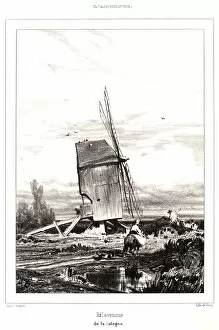Jules Dupre Collection (#2)
Jules Dupré, a renowned French landscape painter from the 19th century, captured the essence of nature's beauty in his remarkable artworks
For sale as Licensed Images
Choose your image, Select your licence and Download the media
Jules Dupré, a renowned French landscape painter from the 19th century, captured the essence of nature's beauty in his remarkable artworks. In "The Cottage by the Roadside, Stormy Sky, " painted around 1860, Dupré skillfully portrays a rustic cottage nestled amidst an ominous stormy sky. The dramatic contrast between light and dark evokes a sense of mystery and awe. In "The Estuary Farm" created between 1830 and 1835, Dupré transports us to a serene coastal scene where land meets water. The tranquil atmosphere is enhanced by his delicate brushstrokes that depict the harmony between man-made structures and nature's vastness. Dupré's painting titled "On the Road" showcases his ability to capture movement and life. Painted in 1856, this artwork depicts travelers journeying through picturesque countryside scenery. The vibrant colors and meticulous attention to detail make you feel as if you are walking alongside them on their adventurous path. "Barks Fleeing Before the Storm, " painted during 1870-75, showcases Dupré's mastery at capturing atmospheric conditions. With bold brushstrokes depicting turbulent waves crashing against small boats struggling to find shelter before an impending storm, he creates a palpable sense of urgency. In another storm-themed masterpiece called "Two Boats in a Storm, " also created during 1870-75 period, Dupré captures the raw power of nature with tumultuous waves threatening two fragile vessels caught in its midst. This painting serves as a reminder of humanity's vulnerability when faced with Mother Nature's wrath. As one explores more of Jules Dupré’s works like “The Old Oak” from around 1870 or “Cows Crossing a Ford” painted in 1836 or even “Landscape with Cattle at Limousin” from 1837; it becomes evident that he had an affinity for pastoral scenes filled with animals grazing peacefully or farmers going about their daily routines.


